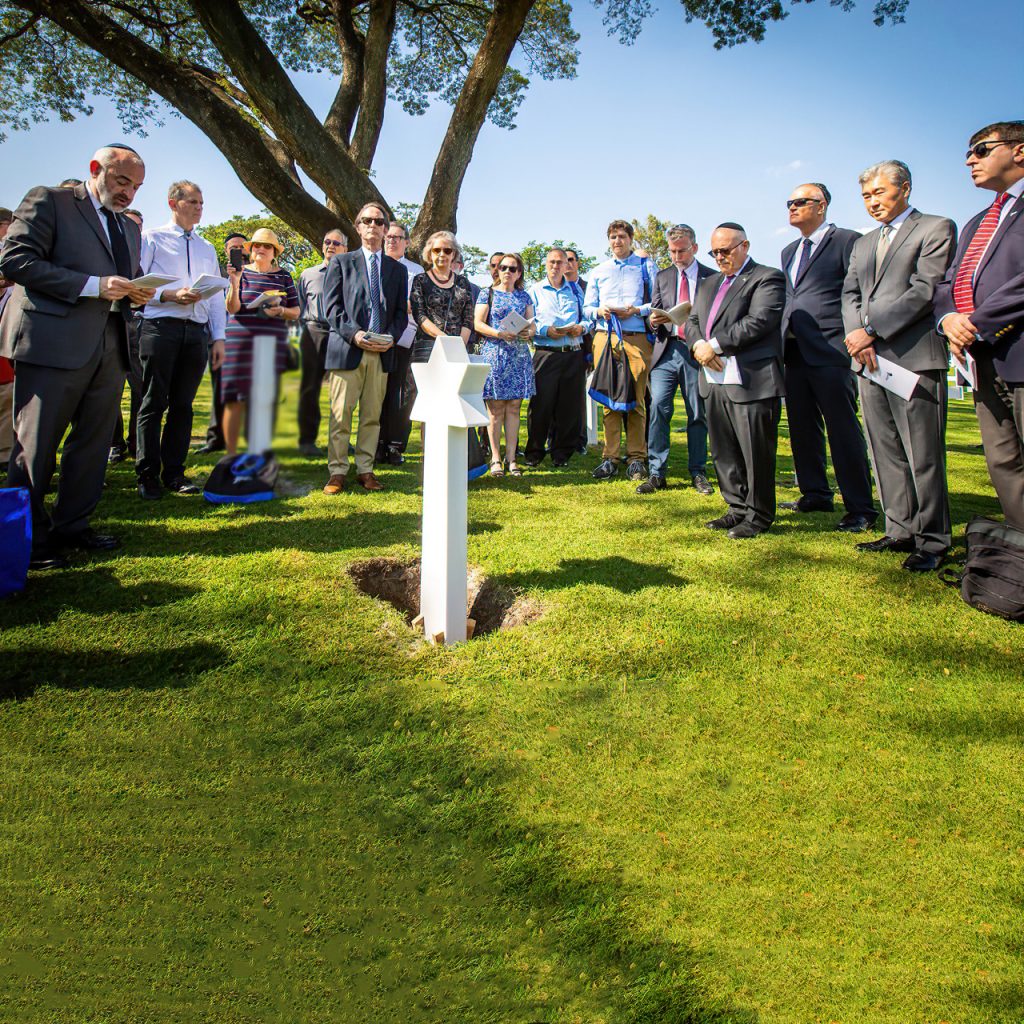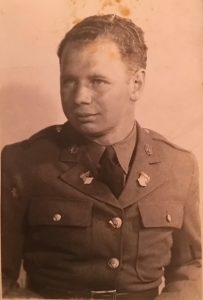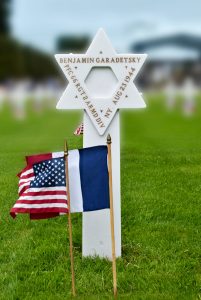Finally, a Star of David for Jewish Heroes

The Headstone Replacement Ceremony of 1LT Robert S. Fink, February 12, 2020, Manila American Cemetery, Fort Bonifacio, Taguig City (Manila), Philippines. Pictured from right to left are, Rabbi John Franken (nephew of PV Allan C. Franken, KIA, 5-24-45), US Ambassador to the Philippines Sung Y. Kim, Israeli Ambassador to the Philippines Rafael Harpaz, Rabbi Dr. Jacob J. Schacter, Steve Lamar, family and friends of the five soldiers killed in action being honored with headstone replacements on that day, and to the very left, Shalom Lamm.
Sam Cordova’s family was among the pillars of the Orthodox Sefardi community in interwar Seattle. They were founders and presidents of the Sephardic Bikur Holim Congregation, a still-functioning synagogue there. The Cordovas kept a kosher home, spoke Ladino and hosted so many guests at their Passover sedarim that they had to set up plywood on sawhorses to extend their dining room table into the living room.
Yet when Corporal Cordova was killed in the Japanese assault on the Philippine island of Corregidor, in December 1941—one of the first American casualties in the South Pacific in World War II—the US army marked his grave with a cross. Why?
Something Was Missing
It was a chilly spring afternoon in the French coastal town of Colleville-sur-Mer. Rabbi Dr. Jacob J. Schacter gazed upon the hundreds of rows of grave markers that fill the American military cemetery at Normandy, contemplating the ultimate sacrifice those young soldiers made seventy years earlier to defeat the Nazis and preserve world freedom. Then a nettlesome thought intruded upon the serenity of that afternoon in May 2014. Something was wrong with what Rabbi Schacter was seeing. Something was missing. Somebody was missing. The Jews.
More than 500,000 American Jews served in the US armed forces in World War II, and about 11,000 of them lost their lives. Most of the fatalities occurred on the European front. Yet as Rabbi Schacter looked out at the vast Normandy expanse where 9,388 American soldiers are buried, virtually all the graves he could see were marked by crosses. “There was a marker with a Jewish star here and there—but they were very few, and very far between,” Rabbi Schacter recalled. It just didn’t seem right.
That hunch would launch the Teaneck, New Jersey rabbi on a years-long mission that not only would bring him back to Normandy again and again, but would take him and a small team of close colleagues to Allied military cemeteries around the world in their quest for historical justice.
What Went Wrong
Rabbi Schacter turned first to his friend Shalom Lamm, a businessman with a master’s degree in American military history. As they began to explore the mystery, it quickly became apparent that the Jewish GIs were not missing, after all—they were misidentified.
Aided by Lamm’s relative by marriage Steve Lamar, an amateur genealogist, and Yeshiva College student volunteer Yaakov Ellenbogen, Rabbi Schacter and Lamm determined that there are hundreds of Jewish soldiers buried under crosses in multiple American military cemeteries around the world.
Rectifying those errors is the goal of their campaign to right a decades-old wrong and ensure that the Jewish GIs who gave their lives for their country can rest in peace at last under the Star of David markers that they would have wanted.
There are several reasons a Jewish soldier might be interred under a cross. The first had to do with the process by which soldiers were temporarily buried near battlefields. Many of the GIs who were killed during the storming of the Normandy beach on D-Day in June 1944 or in the weeks to follow had to be hastily buried on the spot, then later reburied when military cemeteries were established in the region. The army made every effort to determine the identity of the deceased, but when soldiers had to be reburied multiple times, clerical errors sometimes ensued, especially if the GIs’ dog tags—which indicated religious affiliation—became separated from their bodies during battle and were lost.
A second explanation concerned the dog tags. They not only state the GI’s name, rank and serial number, but also bear the designation “P” for Protestant, “C” for Catholic or “H” for Hebrew, in order to ensure that the religious needs of a seriously wounded soldier are met, and that a deceased soldier’s burial rites are conducted in accordance with his faith. During World War II, some Jewish GIs requested a C or a P—or “N,” for no religious preference—for fear of persecution if they were taken prisoner by the Germans; others altered the H to resemble a P—or totally effaced the religious designation on the dog tag—shortly before going into battle.
Every grave marker we could correct would be an act of justice and a teaching opportunity. And, of course, a chesed shel emet.
They had good reason to be afraid; the Nazis did not respect conventional rules regarding treatment of captured enemy soldiers. Some American GIs were sent to the Buchenwald and Mauthausen concentration camps, instead of normal POW facilities. Several hundred US Jewish GIs who were among the American POWs brought to the Stalag IX-B prisoner camp in 1945 were separated from their comrades and sent to the Berga slave labor camp, a subcamp of Buchenwald; thirty-five of them were worked to death, and another thirty-six died on a death march from Berga before the arrival of the victorious Allied armies.
There is also evidence that some American Jewish soldiers may have requested a C or a P, or no designation, for fear of suffering discrimination at the hands of fellow soldiers if their Jewish identity became known. In her book GI Jews, Professor Deborah Dash Moore found that anti-Semitic incidents occurred frequently in the military in the World War II era, sometimes erupting into fistfights.
The team’s research found no evidence that the military authorities ever deliberately chose a cross to mark a grave of a soldier whom they knew to be Jewish. In every instance that mislabeled graves have been uncovered, human error, not malice, was the cause. Because their loved ones were buried in faraway Europe or the South Pacific, many surviving relatives never visited their graves and thus never knew about the crosses; or, if they knew, they did not realize the mistake could be corrected.
Chesed Shel Emet
“Once we understood why the crosses had been erected, we knew we needed to do something about it,” Lamm recalls. “Every grave marker we could correct would be an act of justice and a teaching opportunity. And, of course, a chesed shel emet”—an act of generosity for which there is no expectation of any material reward, in this case because the beneficiary is no longer alive.
One important source of information for the team is to be found in the records of the Jewish Welfare Board, housed at the American Jewish Historical Society in New York City. Many parents of Jewish GIs in World War II filled out a JWB form providing basic family and biographical information so the Board could assist the GI in various ways during his service—for example, via the Jewish chaplains (such as Rabbi Schacter’s father, the late Rabbi Herschel Schacter) whom the JWB helped train. Cross-checking the JWB’s records with US military records of wartime casualties has yielded crucial information.
After confirming through an extensive documentary trail that a soldier who was Jewish is buried under a cross, the team moves into the phase of contacting surviving relatives. Legal next of kin are the only ones who have the authority to formally request that a grave marker be changed. The request is made to the government agency charged with caring for all foreign US military cemeteries, the American Battle Monuments Commission (ABMC). “A country must be judged by how it cares for those who gave their lives for it,” says ABMC leader Major General (ret.) William Matz, with whom Rabbi Schacter, Lamm and their colleagues work closely in addressing these issues.
Contacting the families is a sensitive matter. “For some families, just talking about the person they lost is re-opening a painful old wound,” Rabbi Schacter notes. “For many, it’s shocking and upsetting to hear that their loved one is buried under a cross. And some families are suspicious of our motives. It takes time for them to understand what we’re doing, and why.”

Private Benjamin (Boruch) Garadetsky was killed in a German bombing of his position in France in August 1944. He was one of hundreds of Jewish soldiers buried under crosses in multiple American military cemeteries around the world.
Their First Success
The team’s first success was the case of Pvt. Benjamin (Boruch) Garadetsky, who was killed in a German bombing of his position in France in August 1944. There was no doubt Garadetsky was Jewish; Lamm and his wife, Tina, had visited the Long Island graves of the GI’s parents and saw the Hebrew inscriptions on their headstones. Moreover, Garadetsky, who was born in Russia, had written “Hebrew” under “race” on his 1941 application for American citizenship.
When the team tracked down Garadetsky’s nephew, a doctor in St. Louis, it turned out that the family was aware of the cross and had written to government officials about it many years earlier but had not pursued it. With help from Lamm and Lamar, an official request was submitted through the American Battle Monuments Commission and quickly approved.
On June 20, 2018, Lamar, Rabbi Schacter and dozens of friends and family members of the Garadetskys gathered at the Normandy cemetery for the solemn ceremony at which the cross was replaced by a Star of David. Tehillim were recited, family members shared reminiscences and Rabbi Schacter conducted a memorial ceremony that he created for the occasion; since there is no existing religious service for this uniquely modern occasion, the rabbi improvised. He concluded with the poignant declaration, “Benjamin, on behalf of the citizens of the United States of America, we thank you for making the ultimate sacrifice, and Benjamin, on behalf of the Jewish people, we welcome you home.”
To honor the namesake of their first successful mission, the team gave their campaign a permanent name: Operation Benjamin. They also secured tax-exempt status and began fundraising (the families of the GIs are not charged for any of the expenses involved).
Seven more such ceremonies took place in the year to follow: two brothers, both crew members on bombers, who were buried in France and Belgium; and five GIs who were buried in the Philippines after being killed in the South Pacific or Japanese POW camps.
By early 2020, three more marker replacements had been approved by the ABMC, and ceremonies were being planned in Belgium and France when the coronavirus pandemic struck. International travel ground to a halt, forcing Operation Benjamin to reschedule those for the summer of 2021. Two more marker replacements have been approved, one in Manila, and the other in Rhone, France.
For the past year, the group has focused on researching more candidates, contacting their families, and helping them navigate the application process, while waiting for the day that they can fully resume their chesed shel emet.
*****
 Harry Cordova was the one who answered the door on that fateful day in December 1941 when the army messenger brought the telegram announcing his brother Sam’s death in action. Their mother was a Turkish Jewish immigrant who knew little English; Harry read the telegram aloud. “We simply tried to get through that painful period as best as we could,” Harry, now ninety-nine, explained in his appeal to the army commission. “We did not concern ourselves with his grave marker at the time.”
Harry Cordova was the one who answered the door on that fateful day in December 1941 when the army messenger brought the telegram announcing his brother Sam’s death in action. Their mother was a Turkish Jewish immigrant who knew little English; Harry read the telegram aloud. “We simply tried to get through that painful period as best as we could,” Harry, now ninety-nine, explained in his appeal to the army commission. “We did not concern ourselves with his grave marker at the time.”
Thanks to the efforts of Operation Benjamin, that time finally came. Following the submission of the family’s request, backed up by the team’s research, approval by the commission was swift. Cognizant of Harry’s age, Operation Benjamin, in partnership with the ABMC, proceeded with the headstone replacement ceremony on December 29 in Manila, exactly seventy-nine years to the day that Sam was killed. Harry spoke at the ceremony from Florida via video.
Sam Cordova made the ultimate sacrifice—as a soldier on the battlefield, as a patriotic American, and as a Jew fighting the Axis—and at last he was remembered as an American and as a Jew, as he no doubt would have wanted.
Dr. Rafael Medoff is founding director of The David S. Wyman Institute for Holocaust Studies and author of more than twenty books about American Jewish history and the Holocaust. His latest book is The Rabbi of Buchenwald: The Life and Times of Herschel Schacter (New York, 2021).
